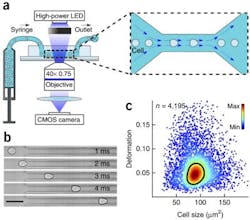Scientists at the Dresden University of Technology have developed a system based on a high-speed camera and microscope that accelerates human cell analysisby a factor of 10,000.
To analyze the properties of cells in just minutes, the scientists developed the AcCellerator system, which is based on Real-Time Deformability Cytometry. In the setup a stream of deformed cells flows through microfluidic channel structure—from right to left— at a speed of 10 cm/s and passes the field of view of a microscope with 400X magnification.
The system is based on an AxioObserver microscope from Zeiss, and also utilizes a high-power LED for microsecond stroboscopic flashes triggered by the camera, a syringe pump with two syringe modules, and a sample holder with magnetic fixation, rotation platform, and cover box with fast clamping for the tubing. Additionally, the AcCellerator has a dedicated computer and frame grabber, and a camera used to capture images of each individual cell.
Connected directly to the microscope is an, an EoSens CL Base camera from Mikrotron. This camera features a 1.3 MPixel CMOS image sensor with a 14 µm pixel size. At a reduced resolution, the camera can capture images at up to 4,000 fps in the microscope setup. All images are transferred in real time to the computer via Camera Link interface and a custom-designed program based on LabVIEW from National Instruments is used for the analysis of each cell’s deformation. The camera also controls the 1 μs short LED light impulse sent out for each image acquisition, according to Mikrotron.
Analyzing a single image, according to the researchers, takes less than 250 μs.
"This enables us to measure the mechanical properties of several hundred cells per second. In one minute, this permits us to carry out analyses that would take a week in technologies we used before", says Dr. Oliver Otto, CEO of Zellmechanik Dresden. Within just 15 minutes, a precise characterization of all blood cell types, including cell activation status, is analyzed. Due to the high throughput of cells, only one single drop of blood is needed for the analysis.
Thanks to the AcCellerator, according to the researchers, cell mechanics evaluation has become possible in clinical applications. Going forward, mechanical fingerprinting of cells could be used for fast diagnosis as well as for monitoring infections. Blood count changes or metastasizing cells, suggests the team, can also be detected in a matter of minutes, which opens new areas of application in research, as this enables users to examine all processes in which the cytoskeleton changes, which is responsible for the mechanical stabilization of the cell.
View more information on the AcCellerator.
Share your vision-related news by contacting James Carroll, Senior Web Editor, Vision Systems Design
To receive news like this in your inbox, click here.
Join our LinkedIn group | Like us on Facebook | Follow us on Twitter
About the Author

James Carroll
Former VSD Editor James Carroll joined the team 2013. Carroll covered machine vision and imaging from numerous angles, including application stories, industry news, market updates, and new products. In addition to writing and editing articles, Carroll managed the Innovators Awards program and webcasts.
